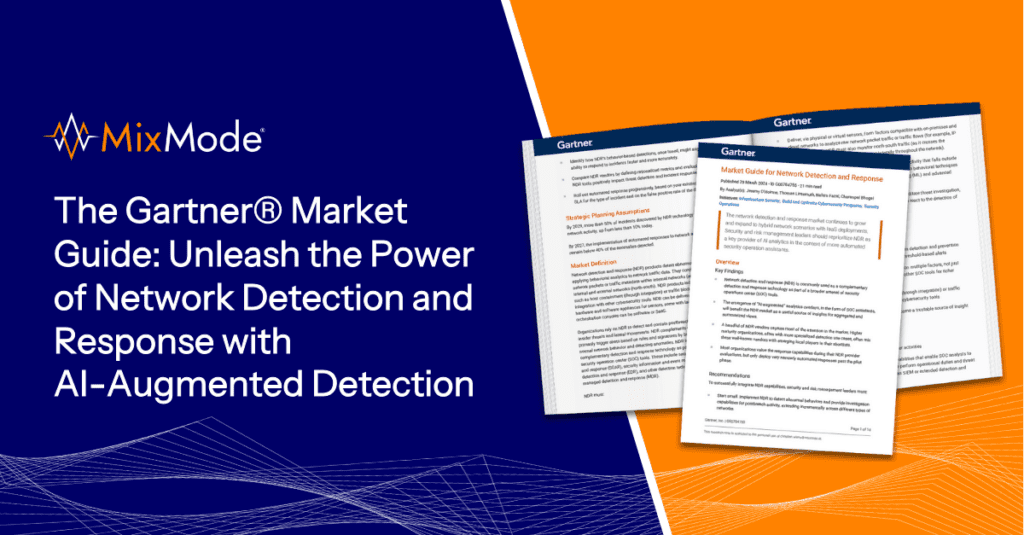 Joe Ariganello VP of Product Marketing
Joe Ariganello VP of Product Marketing
Joe is the VP of Product Marketing at MixMode. He has led product marketing for multiple cybersecurity companies, with stops at Anomali, FireEye, Neustar and Nextel, as well as various start-ups. Originally from NY, Joe resides outside Washington DC and has a BA from Iona University.
Network security is a constant battleground, and organizations increasingly turn to Network Detection and Response (NDR) solutions to gain an edge. But how effectively are these tools being implemented?
Gartner’s recently released Market Guide for Network Detection and Response offers valuable insights for security leaders looking to optimize their NDR strategy. One of their key findings is the emergence of Augmented NDR solutions and the exciting potential of AI-powered “augmented analytics.”
What is Augmented NDR?
Augmented NDR leverages the power of Artificial Intelligence (AI) and Natural Language Processing (NLP) to enhance traditional Network Detection and Response (NDR) solutions. These new analytics overlays gather data from various sources, including EDR, NDR, SIEM, and threat intelligence feeds, then use NLP and summarization techniques to present security teams with a clear picture of potential threats.
Traditional NDR vs. AI-Augmented NDR: The Fight Against Alert Fatigue
NDRs help security teams identify and respond to threats by monitoring network traffic for suspicious activity. (Click here for a deeper dive.) However, traditional NDRs have limitations that can leave security teams vulnerable. This is where AI-augmented NDR comes in, offering a powerful upgrade to signature-based network detection and response.
Traditional NDR: Strengths and Limitations
Traditional NDRs excel at collecting and analyzing network data to identify patterns indicative of malicious activity. They can detect activities like unusual data exfiltration attempts or lateral movement within a network. Here’s what traditional NDR solutions do well:
- Visibility into Network Traffic: NDRs provide a comprehensive view of network activity, allowing security teams to monitor for anomalies.
- Real-time Threat Detection: NDRs can detect threats in real-time, enabling faster response and potentially preventing damage.
- Automated Threat Analysis: NDRs can automate some aspects of threat analysis, freeing up security analysts for more complex tasks.
Traditional NDRs also have limitations, including:
- Alert Fatigue: The sheer volume of alerts generated by NDRs can overwhelm security teams, leading to alert fatigue and potentially missed threats.
- Limited Context: Traditional NDRs may struggle to provide context around alerts, making it difficult to determine their severity and prioritize investigation.
- Evolving Threats: Traditional NDRs rely on predefined rules and signatures to identify threats. Sophisticated attackers can often bypass these rules, leaving NDRs blind to new threats.
AI-Augmented NDR: The Power of AI
AI-augmented NDR takes NDR to the next level by incorporating Artificial Intelligence (AI) and Natural Language Processing (NLP) to overcome the limitations of traditional NDRs. Here’s how AI-augmented NDR solutions enhance threat detection:
- Reduced Alert Fatigue: AI can filter and prioritize alerts, highlighting the most critical events for investigation and reducing alert fatigue for security teams.
- Advanced Threat Detection: AI can analyze vast amounts of data and identify subtle patterns that might escape human analysts. This allows for faster detection of novel and sophisticated threats.
- Contextual Awareness: AI can enrich alerts with context from various sources, helping security teams understand an event’s potential impact and prioritize response.
Why Traditional NDRs Alone Aren’t Enough
While traditional NDRs offer valuable capabilities, relying solely on them can leave your organization exposed. Here’s why:
- Security analysts are stretched thin. The constant barrage of alerts from traditional NDRs can make it difficult for security teams to keep up, potentially leading to missed threats.
- Advanced threats are constantly evolving. Traditional NDRs may struggle to identify new and sophisticated threats that haven’t been programmed into their rules.
- Security teams need more context. Without context around alerts, it’s difficult to determine their severity and prioritize investigation.
What does AI Augmented NDR mean for security teams?
Augmented NDR represents a significant leap forward in threat detection and response, empowering security teams with:
- Reduced Alert Fatigue: Security teams are bombarded with alerts from various security tools. Augmented NDR filters and analyzes this data, prioritizing critical events and providing summaries with context, allowing security personnel to focus on what truly matters.
- Improved Threat Detection: AI can identify subtle patterns and connections across disparate data sources that human analysts might miss. This enables faster detection of advanced threats that traditional methods might overlook.
- Enhanced Efficiency: Augmented NDR frees up security analysts for more complex investigations and strategic decision-making by automating tasks like data aggregation, summarization, and basic threat analysis,
Why MixMode is Poised for Success in Augmented NDR
MixMode is a leader in delivering Augmented NDR, with our focus on hybrid network coverage and expertise in artificial Intelligence. Here’s why:
- Strong Foundation in Network Analysis: MixMode’s NDR solution excels at performing continuous network behavioral analysis across diverse environments. This provides strong real-time visibility for utilizing AI to identify suspicious patterns and anomalous activity.
- Advanced Threat Detection Capabilities: MixMode’s AI continuously learns and adapts based on continuously observed behavior. This allows MixMode’s AI to detect novel advanced attacks, including zero-day attacks that haven’t been seen before.
- Focus on Efficiency: MixMode automatically prioritizes detected security events based on AI confidence, potential impact, and relevance to the organization’s specific threat landscape. This proactive approach enables organizations to focus on the cyber threats that matter to them.
Unlike signature-based network security tools, The MixMode Platform utilizes behavioral analytics to provide actionable insights that help security teams quickly identify malicious network activity.

The Future of Security is Augmented
Augmented NDR solutions like MixMode can empower security teams to identify and neutralize cyber threats faster and more efficiently. As the threat landscape continues to evolve, Augmented NDR is poised to become an essential tool for any organization seeking to stay ahead of cybercriminals.
Download Gartner’s complete Market Guide for Network Detection and Response to learn more, or reach out to MixMode to see how we can help.
Other MixMode Articles You Might Like
RSA 2024: AI Security Takes Center Stage
MixMode Honored as AI Security Solution Leader in 2024 Cybersecurity Excellence Awards
Whitepaper: The False Promises of AI in Cybersecurity
Global Cybercrime Report 2024: Which Countries Face the Highest Risk?
Unveiling the Power: A Strategic Look at the Benefits of Using AI in Cybersecurity
*** This is a Security Bloggers Network syndicated blog from MixMode authored by Joe Ariganello. Read the original post at: https://mixmode.ai/blog/augmented-ndr-gartner-unveils-the-future-of-threat-detection-with-ai/
